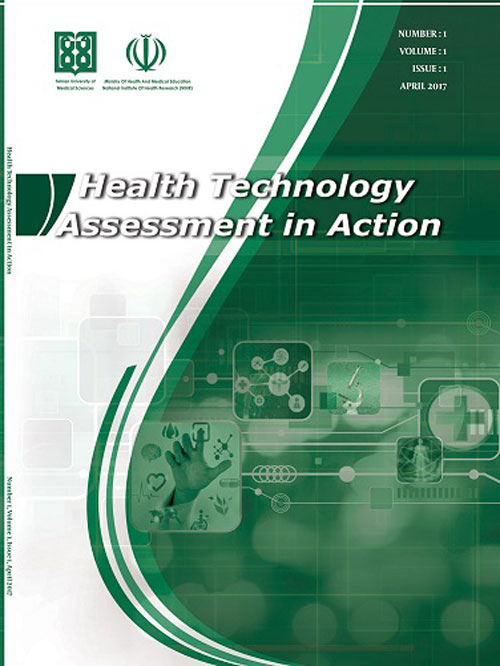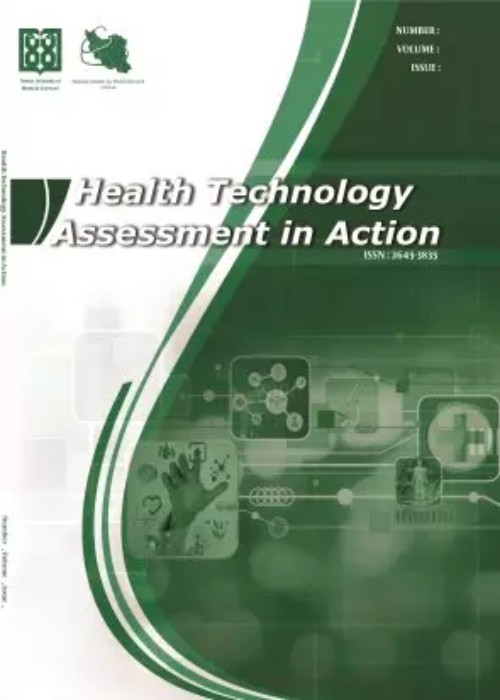فهرست مطالب

Health Technology Assessment in Action
Volume:1 Issue: 2, Oct 2017
- تاریخ انتشار: 1396/07/20
- تعداد عناوین: 4
-
-
Page 1Background and Objectives
The most common type of hair loss is androgenetic alopecia. Mesotherapy is considered a contro-versial treatment for this condition. The aim of this study was to examine the safety and efficacy of mesotherapy in the treatmentof androgenetic alopecia.
MethodsA systematic review was conducted to identify and evaluate relevant studies on mesotherapy for the treatment of andro-genetic alopecia. The Cochrane Library, PubMed, Embase, Scopus, and Web of Science were searched until November 2017. The greyliterature and references of key studies were also scanned for additional citations. In addition, quality assessment of studies wasconducted using the Jadad scale.
ResultsFive studies including 344 patients were considered eligible for the review. Of five studies included in this review, three wererandomized controlled trials (RCTs) and two were non-RCTs. In previous studies, mesotherapy was performed using dutasteride,minoxidil, and finasteride. As the analysis revealed, quality of retrieved studies was poor. The results showed that mesotherapyleads to the improvement of efficacy outcomes. However, in one study, mesotherapy was not shown to be effective regarding someoutcomes. No significant adverse effects were reported for mesotherapy.
ConclusionsAlthough the findings of previous studies suggest that mesotherapy is a safe and effective treatment for androgeneticalopecia, further research is needed to confirm this finding
Keywords: Mesotherapy, Alopecia, Hair -
Page 2Background
This study aims to investigate the effectiveness of mechanical thrombectomy compared with thrombolytic therapyin patients with acute stroke.
MethodsThis study is a systematic review on clinical studies, as the Cochrane library, PubMed, Google Scholar, Web of Science,and Embase databases were searched. The time span selected to retrieve articles is 1990 to 2017. The quality of the articles foundwas evaluated by the CONSORT checklist. Fixed effects and random effects models were employed for meta-analysis. Results weresubject to sensitivity analysis in specified curtained interval, CMA (Comprehensive Meta-Analysis software): 2 software was used tocarry out the meta-analysis task, and alpha was set to 5%.
ResultsThe eight papers found met the inclusion criteria. Patients in mechanical thrombectomy group had a significantly higherimprovement rate compared to the thrombolytic therapy group [OR 1.71 (1.182.48), P = 0.005]. There were no significant differencesbetween mechanical thrombectomy and thrombolytic therapy groups regarding intracerebral hemorrhage ([OR 1.03 (0.71 - 1.49),P = 0.88]). Mechanical thrombectomy was more effective in reducing mortality rate of patients, however, this difference was notsignificant ([OR 0.84 (0.67 - 1.05), P = 0.12]). The effectiveness of mechanical thrombectomy is superior to thrombolytic therapybased on the improvement rate, 90-day mortality and symptoms of intracerebral hemorrhage OR: 2.23 (1.77 - 2.81), P < 0.00001; OR0.79 (0.60 - 1.05), P = 0.10, and OR 1.02 (0.61 - 1.70), P = 0.95, respectively.
ConclusionsThrough some good criteria for selecting appropriate patients, mechanical thrombectomy can be superior to throm-bolytic therapy in patients with acute stroke.
Keywords: Acute Stroke, Mechanical Thrombectomy, Thrombolytic Therapy, Meta-analysis


